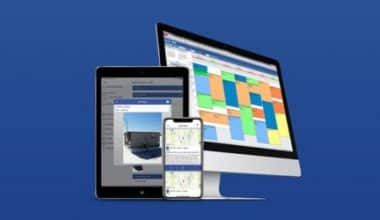A valuable asset is something that can be useful in any situation. Investment in assets is a must for any company. Despite its vagueness, the term “asset” is commonly understood to refer to anything that can be owned and put to work accumulating or generating capital. The actual and intangible assets that your company possesses. As of 2020, the various companies that make up the asset management industry held over $100 trillion in assets, according to a report by the Boston Consulting Group. There’s no easy way to conceptualize the enormity of this sector. Hiring a top asset management company is a good idea if you want to amass wealth but lack the resources to keep tabs on international markets on your own. In this article, we will discuss company asset management software, how to start an asset management company, and how they make their money.
What Is Company Asset Management?
An asset management company (AMC) is a company that invests clients’ money on their behalf, using the money to purchase stocks, bonds, real estate, MLPs, and other assets. AMCs manage a wide variety of investment portfolios, including those of high-net-worth individuals (HNWIs), pension plans, hedge funds, and, to better serve smaller investors, mutual funds, index funds, and exchange-traded funds (ETFs).
Furthermore, money managers and money management firms are common synonyms for asset management corporations. The term “asset management company” can be used to describe a wide variety of organizations, including hedge funds, private equity funds, and new fintech firms that automate investment.
Companies specializing in asset management are experts in creating tools that streamline the investment process. Asset management firms use their size and in-house experience to create funds that purchase and sell investments like bonds and stocks, saving their clients the trouble of setting up their own trading desk and keeping track of thousands of equities. Alternatively, they may give a technology that is used to enter these sectors. Asset management firms may collect fees from their clients as compensation for their services. Some major asset management companies are able to offer no-fee funds or commission-free trading because they take use of economies of scale to keep customer expenses low.
In addition to offering goods for investment, most asset management companies also provide access to an array of research and forecasting tools, such as retirement savings calculators, automated portfolio rebalancing, and others, to assist clients in making well-informed decisions regarding their portfolios.
The asset management company is huge because it serves clients with a wide range of demands, from large corporations to individuals starting out with a small investment.
What Are the 3 Main Asset Management Types?
Regardless of the nature of your company’s assets, proper management is the key to increased productivity and responsibility. Understanding various types of asset management will allow you to research and select the most appropriate one for your company.
The first step in establishing a new and better way of working with your assets is to find a suitable fit for the nature of your organization and one which serves your staff and customers well.
Supply chain decision-makers, chief operating officers of enterprises with physical assets of any kind, especially those involved in fieldwork, and organizations responsible for a wide variety of equipment can all benefit from reading this post.
Finding the right type of management for your company’s assets is crucial for making the most of those assets.
An asset management system that includes GPS tracking may not be necessary for a corporation whose stock never leaves the building. However, knowing where a product is in the supply chain will have significant benefits for a multinational company.
One of the most important steps in selecting a practical system is becoming familiar with the various asset management options available. We’ll go through a few different categories and what they entail.
#1. IT Asset Management (ITAM)
Management of both physical and digital assets is included in IT asset management.
Besides tangible assets like computers, routers, and other IT hardware, intangible assets like software as a service (SaaS) subscriptions, licenses, patents, and network infrastructure are also included.
Safeguarding data, cutting costs, and laying a solid technological foundation are all benefits of IT asset management. In-house and cloud-based data storage, retrieval, organization, and sharing systems are all part of this process.
Assets can be easily tracked and updated, and digital files can be kept on hard drives and backed up in the cloud. An easy-to-use organization and storage system helps save time.
All of your conversations and video conferences will be safe and sound. You can scan for and remove duplicates, clean off malware, and quickly update across all platforms.
It doesn’t matter what kind of business or service is being discussed, IT management is applicable due to the universal need for real-time communication and file sharing in today’s modern organizations. Also, read IT ASSET MANAGEMENT: Meaning, example, systems & software.
#2. Digital Asset Management (DAM)
Management of digital assets is a dynamic area of study. It entails the processing and storage of digital files and content in an effective manner. In addition, metadata are part of this technique that runs indefinitely.
Furthermore, Stakeholders save money by limiting who can access the intellectual property, building designs, and meeting recordings, rather than keeping several copies of each in different locations.
Moreover, they have a higher level of security against the hazards of fire and water.
By implementing a reliable DAM system, you can:
- Consistency in branding that works
- Responsible use of digital resources
- Quick and simple access to digital content regardless of experience level
- Instantaneous dissemination of digital information is possible.
- Marketing efforts can benefit greatly from knowing the who, what, when, and for how long of digital content users are interacting with
- Possibilities for the Reuse of Digital Assets.
Companies that don’t focus on selling digital products can nevertheless benefit from implementing DAM systems. It is increasingly common practice to save frequently used documents like time cards, manuals, and instructions in a user-friendly cloud-based system.
#3. Enterprise Asset Management
The field of enterprise asset management is expanding rapidly. It manages and improves the effectiveness of a company’s physical assets and infrastructure over time. The state of the facilities, as well as documentation, output, and inventory records, are all part of this.
The acronym EAM stands for “enterprise asset management.” However, when compared to the other asset management methods covered here, EAM stands out due to its holistic nature.
A company should Look for a system that has the following features when shopping for enterprise asset management software:
- Instantaneous computing and emailing
- The Art of Data Display
- Customized spreadsheets, graphs, and output targets
- The capacity to generate precise and personalized reports
In addition to managing work orders and alerts, EAM software may also keep track of warranties and regulatory compliance.
Company Asset Management Software
Companies in the modern digital era have a greater number of assets to monitor and manage. IT asset management has become more challenging as a result of the proliferation of mobile devices in the workplace, the maturation of cloud computing, the rise of proprietary software, and the increased frequency of software updates. Furthermore, high rates of employee turnover pose risks to data privacy.
A company asset management software (AMS) is necessary in these cases. As a result, organizations may save money on IT and software while still keeping a close eye on their assets. They offer a complete picture of an asset’s existence, from purchase and installation to eventual retirement and disposal. Even while a company could utilize a simple spreadsheet to keep track of its assets, having access to asset-specific data analysis through asset management software would help it to make better asset management decisions.
In addition, keeping asset management records manually is a thing of the past. Asset management software comes in a variety of forms today, each of which helps a company maintain an accurate inventory of its possessions while also reducing administrative overhead.
Best Company Asset Management Software
Here is a list of the best company asset management software including price, suitability, and best features.
#1. Atera
You can manage an unlimited number of devices and endpoints for one low monthly fee with Atera’s innovative and inexpensive per-technology pricing approach.
You can subscribe on a month-to-month basis, or take advantage of the annual savings. Also, you can try out all of Atera’s features for 30 days, and there are three different licensing kinds to select from.
MSPs, IT consultants, and company IT departments can use Atera’s cloud-based Remote IT Management software. Atera’s limitless stock tracking and maintenance service is available for one affordable monthly fee.
In addition, Atera’s Network Discovery module finds unmonitored hardware and business opportunities instantaneously. Atera is the comprehensive package of IT administration tools you’ve been looking for.
Atera offers RMM, PSA, network discovery, remote access, patch management, reporting, script library, ticketing, and a support desk.
Features:
- Easily Keep an eye on and control an infinite number of Mac and Windows devices.
- Search and record all connected gadgets, keep track of software stock, and monitor licenses using inventory management.
- Discover SNMP devices, printers, firewalls, switches, routers, and more with an instant network scan that just takes a few minutes.
- The ability to generate reports automatically that monitor the status of your systems, assets, network, and performance.
- Set alert thresholds and preferences, and have them automatically updated and maintained.
- Keep an eye on everything you’ve got under control by actively tracking its status and performance.
- Use a unified system for managing tickets and payments for fixing network problems.
Atera is the best IT asset management software for a service company and IT professionals due to its affordable fixed pricing for an unlimited number of devices and its fully integrated solution. There is no risk in trying it out. Get full access to everything Atera has to offer with no obligation or credit card required.
#2. SuperOps.ai
Ideal for MSPs and IT departments on a medium or small scale. SuperOps.ai offers a 21-day free trial during which you may try out the entire functionality of the platform with no obligations or hidden costs. A demo or free trial can be scheduled.
All the tools you’ll need to keep track of and maintain your client’s network assets are included in SuperOps.ai’s user-friendly IT management platform, which is powered by Remote Monitoring and Management (RMM). In addition, Professional Services Automation (PSA) is built in for full context.
Remote desktop administration, community scripts for potent automation, patch management to keep endpoints up to date, system tray icons for enhanced accessibility, and much more are just a few of the slick features it offers to help technicians perform at their peak.
Features:
- Comprehensive remote desktop administration tools include RegEdit, Terminal, and a file browser.
- PSA, RMM, Remote Access, Patch Management, Reporting, Community Scripts, Third-Party Integrations with Webroot, Bitdefender, Acronis, Azure, and much more are all available in a single, centralized location.
- Management of third-party software, including automatic client-end software installation, patching, maintenance, and uninstallation.
- You can monitor the state of your assets in real-time with the help of a summary that shows metrics like firewall activity, CPU and memory utilization, antivirus protection, and more.
- Granular reporting to track performance data of assets, alerts, patch health, antivirus health, and more.
- $79 per technician for all RMM features.
- Easy-to-use, modern, and intuitive user interface.
- Free onboarding, implementation, and readily available customer support.
- Completely free Splashtop membership and seamless integration.
If the IT staff of your company needs comprehensive software for remote asset management and proactive problem solving, go no further than SuperOps.ai. You can try out SuperOps.ai without any commitment for 21 days during the trial period.
#3. Ivanti
The Ivanti IT Asset Management Suite has several useful features. However, its reporting functionality stands out as particularly useful for businesses that want to clearly and concisely highlight crucial data points. Ivanti IT Asset Management is the best choice for custom reporting asset management software because of the extensive library of pre-made reports and the flexibility to create new queries.
Asset identification, financial management, software compliance, and licensing management are just some of the many services that Ivanti provides to help companies keep track of and manage their IT assets during their entire lifecycle. Users familiar with the Windows operating system will appreciate the setup’s Windows-based interface. The wizard guides you through an easy-to-follow process that culminates in your first network asset scan and includes lessons on configuration and management. In addition, the software applications can then be installed on those machines following the initial scan.
However, Ivanti does not provide a cloud-based service, therefore it requires a more extensive installation with at least some server hardware. The benefit of an on-premise installation is a quicker reaction time for asset discovery and report production for firms that can manage it. As was previously said, the reports produce results promptly, even after modifying queries to obtain additional information.
Similar to InvGate Assets, Ivanti bases its pricing on the number of agents in use, rather than the total number of supported nodes. The pricing does not factor in IP phones, routers, or any other network hardware that cannot run an agent. Instead of listing prices on their website, Ivanti requests that potential customers get in touch with them to discuss a quote.
In addition, you can try out Ivanti’s Asset Management Suite without spending a dime.
#4. SuperOps.ai
Nifty is a central hub for teams to work together and share visual project management tools to improve transparency and communication across IT departments.
Furthermore, Nifty excels with both setup, long-term implementations, and agile, post-implementation-measurement operations like ticket management. Whether your goal is process management or problem-solving at lightning speed, Nifty is the tool around which your team will rally.
Features:
- Downloadable.CSV and.PDF reports for both milestones and tasks.
- Standardizing data throughout the account is made possible with the use of Task Tags and Custom Fields.
- When major milestones in a project’s lifecycle conclude, additional ones are put in to demonstrate the project’s progress.
- Creating and storing project documents such as contracts, scopes, and information.
- Ingest all roadmaps at once with cross-portfolio reporting.
Pricing:
- Starter: $39 per month
- Pro: $79 per month
- Business: $124 per month
- Enterprise: Contact them to get a quote.
#5. Pulseway
When it comes to mobile asset monitoring and management, MMSoft Pulseway is hard to beat. In contrast to competing remote monitoring and management solutions, Pulseway was designed from the ground up to be used on mobile devices. For this reason, we recommend Pulseway as the top asset management software for company mobile programs.
However, as one would expect from a mobile-first solution, Pulseway offers a state-of-the-art and intuitive interface across all devices and operating systems. Machine connectivity is nearly quick, and the user interface is straightforward and aesthetically pleasing.
The Pulseway mobile app allows you to troubleshoot cloud-based servers and other operating systems, in addition to remote desktop access to Windows machines. From the mobile client, you can kill processes, restart, log out, suspend, and lock non-Windows-based resources.
The provision of instantaneous updates via the smartphone app is a major step forward. In-depth notification settings let you pick and choose which services to monitor and when.
The lack of robust reporting options is a major drawback of Pulseway. When compared to competing products, the amount and flexibility of available pre-built reports is limited. The reports are available both on-screen and in an email attachment.
For as little as $22 per month, you can get Pulseway’s Professional plan for your team of 20 computers. In addition, a fully functional 14-day trial is also available.
#6. InvGate
With its comprehensive feature set, simple installation process, and user-friendly interface, InvGate Assets is our top pick for small and medium-sized enterprises in need of an asset management solution.
Advanced reporting, network discovery, remote desktop access, change management, licensing management, software deployment, and software metering are just some of the setup capabilities of InvGate Assets that help firms keep track of their assets. InvGate’s intuitive interface makes for a quicker onboarding process. Getting reports is as easy as doing a routine search and then exporting the data to Microsoft Excel, thanks to the straightforward interface.
The alert system in InvGate may be quickly and easily set up to notify users of any issues with their assets. Adding assets to the system is as easy as installing a tracking agent on any machine or device. Clients running Windows, Mac OS X, and even Linux are all supported by the system.
The cost of InvGate Assets rises in proportion to the number of node connections. Only hosts where the InvGate Assets agent will be installed are considered. The number of nodes does not include IP phones, printers, routers, fax machines, or any other types of access points.
Insight, Service Desk, and Assets are the three tiers of service that InvGate provides, although the company does not make pricing information easily accessible. Requesting a quote involves filling out a form and waiting for the company to get in touch with you.
In addition, if your company has a small IT management and could use some extra help, InvGate’s support software is perfect for you.
How to Start an Asset Management Company
The primary function of an Asset Management Company, or AMC, is to maximize the financial returns for their retail clientele by investing the various types of client assets in various sectors. The money is put into various investments like equities, bonds, mutual funds, and real estate. Businesses in this industry are now more commonly referred to as “asset managers” or “money managers. However, ” Companies like these are useful for spreading financial risk across a variety of sectors. Here are simple steps to start an asset management company.
#1. Investment Objectives/ Criteria
Investment managers need to think about the different types of assets they have at their disposal at various phases. When allocating assets, keep the following in mind.
Equity or Debt Distribution of Assets
- Market Analysis
- Financial Research for Investment Portfolios
- Expertise and Best Practices in Asset Management.
#2. Management of Investment Portfolios
Developing an investment portfolio is a critical next step for effective management. Market analysis and the consideration of potential market declines and trends are essential tasks for asset managers. The market study should also take into account the potential risks. Whether or if the investment can be made in high-rated securities is a major factor.
#3. Tracking Progress
The final step of an AMC is a consistent analysis of the portfolio and the rate of return it is producing. Reports are required for these. Reports on the assets’ performance must be given to clients by the asset managers.
What Are 3 Methods That Are Used to Manage Asset Management?
There are numerous approaches to managing assets. Whether or not you know it, you and your team are already using an asset management system. Asset management frequently occurs using one of three approaches:
#1. Internal Inventory Tracking System
Asset management technologies integrated into storage for creative teams is a trend that began in about 2015. This service is provided by a number of companies, including Facilis, ProMAX Systems, EditShare, and Studio Network Solutions. In addition, these are frequently included in storage packages at no extra charge.
The benefits of this approach include working with a single vendor for both storage and asset management, as well as a solid balance of sophisticated functionality but with higher ease of use than an add-on DAM system. These can serve as a happy medium between a do-it-yourself solution and a custom-designed system.
Locking yourself into a single provider for data storage and asset management is a major drawback of this approach. Because of this, switching suppliers is a major hassle.
#2. Handling Assets Manually
Instead of investing in a robust Asset Management system, many businesses rely on spreadsheet programs like Microsoft Excel or Google Sheets to track their projects, data, and physical locations.
This strategy has a lot going for it because it is simple to implement, adaptable, and requires no initial capital outlay.
This approach is not without its drawbacks. Because it’s entirely manual and doesn’t scale well, it’s easy to fall short of the intended result of getting digital assets in order.
#3. Content Management Systems for Digital Media
DAM (Digital Asset Management) and MAM (Media Asset Management) software are two common types of software used for this purpose. Some excellent choices for video and creative asset management are CatDV, Axle.ai, and iconik.
Powerful tools like AI tagging and auto-indexing are just two of the many benefits of this approach. The method also integrates seamlessly with a wide variety of professional applications, like Adobe Premiere and Frame.io, which you may already be using.
Complexity is typically the biggest issue with this approach, followed by price. Since these programs are so versatile, it’s easy to become overwhelmed by all of the available features and end up never using them.
Top Asset Management Company
Here are the top asset management company.
#1. UBS Group
The Zurich-based UBS Group asset management company boasts that it is unique among its competitors. In comparison to Goldman Sachs and the Vanguard Group, they are much smaller, operating in only 23 markets with 3,600 workers and 880 investment professionals.
UBS is known for encouraging client autonomy by not mandating any one investment approach. They advocate for a wide variety of investing strategies to foster creativity and growth.
Furthermore, UBS specialize in equity, fixed income, multi-asset, currency, hedge funds, private markets, real estate, and sustainable investing, making them one of the fastest-growing asset management firms available. They also provide UBS funds and UBS exchange-traded funds.
UBS has won recognition for its cutting-edge technological capabilities and extensive online learning materials. Their website is where they publish their results and research, and it is regularly updated with new information. UBS’s account holders are consistently updated, so they’re perfect for those who like to know everything at all times.
If you’re searching for a specialized partnership with your asset management firm, UBS Group may be the perfect option for you and your investing needs.
#2. The Vanguard Group
The Vanguard Group is worth $7.5 trillion, making it the world’s second-largest AMC. Vanguard is an established financial services provider with headquarters in Malvern, Pennsylvania, and a global workforce of 18,800. It began in 1975 and has investors in more than 160 countries.
Mutual funds, ETFs, brokerage and trust services, asset and wealth management, variable and fixed annuities, financial planning, and instructional materials are all available at reasonable costs.
Vanguard, which places a premium on ownership, subscribes to the business model of “investor ownership,” which treats investors as if they were part owners of the company and promotes mutually beneficial relationships. Also, they claim to place a premium on protecting the long-term financial interests of their clients as asset managers.
The Vanguard Group is an excellent choice for assessment management because of its long history of success.
#3. Fidelity Investments
Fidelity Investments is a Boston-based, global financial services firm. With $6.7 trillion in assets under management and total customer asset value and 36,000 workers in 9 countries, it is another one of the world’s largest asset managers.
Including stock, high-income, hybrid, investment-grade bonds, and money market assets, Fidelity’s total discretionary assets are roughly $4,283.3 billion. They are able to invest in things like real estate, commodities, alternative investments, and absolute returns.
If you’re searching for a large asset management organization with a proven track record, Fidelity Investments is a solid option for both novice and seasoned investors.
How an Asset Management Company Makes Money
Here are ways asset management company makes money.
- Earnings in the form of expense ratio
- Gains from the collection of exit load fees
- Charges from portfolio management services
- Payment for advice.
Conclusion
Since there is a wide variety of services and products available from various banks, it is vital to first define your financial goals and then conduct thorough research to choose the ideal financial institution for your needs.
If you’re a business owner, entrepreneur, or salaried worker with a significant amount of disposable income but lack the expertise, time, or resources to make sound investment decisions on your own, an asset management company can help.
FAQs
What are the benefits to asset management companies
- Economies of scale
- Exposure to a variety of asset classes
- Superior Knowledge
What is another name for asset management?
Another name for asset management is wealth management.
Similar Articles
- ASSET SALE: Definition, Comparisons, & All You Need
- HOW TO FIND REMOTE JOBS in 2023: Best Easy Guide b)
- DIGITAL ASSETS: Definition & How to Manage Them Effectively
- ASSET MANAGEMENT SYSTEM: Benefits & Top 5 Software Solutions
- SYSTEM INTEGRATION: Definition, types, system & control






